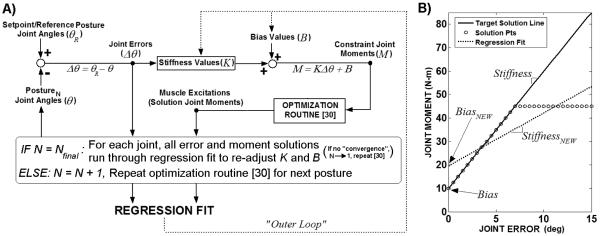Figure 2.
A: Diagram of iterative regression scheme to determine maximal stiffness (K) and corresponding bias (B) moment values for each joint. For given set of K and B values for all joints, optimization routine [30] applied to all postures. Due to limitation in SCI muscle strength, all constraint moments, defined according to K and B, unlikely to be met by optimizer solutions. Linear regression applied to entire moment versus error solution space to re-adjust K and B (“outer loop”) according to fit for each joint DOF and in each direction. Note: For a bi-directional (e.g., flexion and extension) joint DOF, Bnet = mean(Bflexion, Bextension). Optimization routine [30] re-applied to all postures to determine solutions for new constraint moment targets. Iteration scheme continues until convergence (mean ∣ΔK∣ < 0.005N/m-deg). The joint errors and muscle excitation solutions corresponding to the final K, B values serve as the ANN inputs and outputs, respectively. B: Example of linear regression applied to solution space for single joint DOF in one error direction. Optimizer produces either feasible solution points adhering to target solution line, representing constraint joint moments for given iteration, or infeasible solutions points deviating from target solution line. Linear regression applied to entire solution (feasible and infeasible) space to re-adjust K, B for next iteration.

